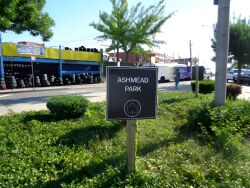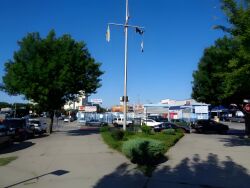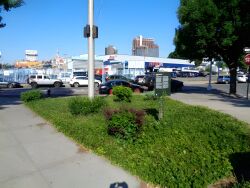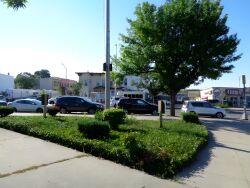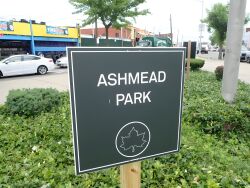Ashmead Park
Ashmead Park
This small triangular park was once used as a dumping ground for agricultural waste by farmers from nearby St. Albans and Springfield—a practice increasingly considered a nuisance as the area developed in the 19th century. In the 1880s, a Jamaica couple originally from England—Alfred and Amelia Ashmead—purchased the property and created a community garden. The Ashmeads transformed the space into “the show place of Jamaica Village” wrote the Brooklyn Eagle, a paradise of "roses, peonies, gladioli and hollyhocks . . . whose fragrance and beauty residents from all over the village came to enjoy."
The Ashmeads eventually deeded the property to the village for a public park. In 1898, when Jamaica was incorporated into greater New York City, the park came under new jurisdiction. A tiny space on the rural edge of town, it was effectively forgotten and by 1910 had become derelict and overgrown with weeds.
In 1914 the Jamaica Women’s Club, led by Kate Porter Blanchard, partnered with the Queens Department of Parks to create at Ashmead Park the borough's first public playground. It was well equipped, with "every form of apparatus . . . swings, see-saws, quoits (a ring-toss game), playground balls and a sand-bin," noted The Daily Standard Union. The park was formally opened on July 31, 1914. Some 400 children attended the event, which featured a band, ice cream, and a speech by Park Commissioner John E. Weier. Like most city playgrounds at the time, Ashmead Park was supervised by a "play director." The Women's Club rented a nearby store to shelter children in the event of a storm and to keep first-aid supplies. Harriet Hassler of the Queens Children's Library curated a weekly "storytelling hour" for younger children.
But little was done to maintain the new playground, and by the late 1920s Ashmead Park was again in deplorable shape. A 1929 exposé in the Brooklyn Eagle called attention to its decline. It was soon restored and opened again as a supervised playspace under the auspices of the Queen's Council of Social Agencies in June, 1930.
Ashmead Park was cut in half when Liberty Avenue was re-aligned through the space in the late 1930s. Too small and surrounded by traffic, it was no longer suitable for a playground. Today it survives as a little island of green, anchored by a flagpole, commemorating the long-ago generosity of the Ashmeads and their commitment to improving life in our city.
Check out your park's Vital Signs
Clean & Safe
Green & Resilient
Empowered & Engaged Users
Share your feedback or learn more about how this park is part of a
Vital Park System

